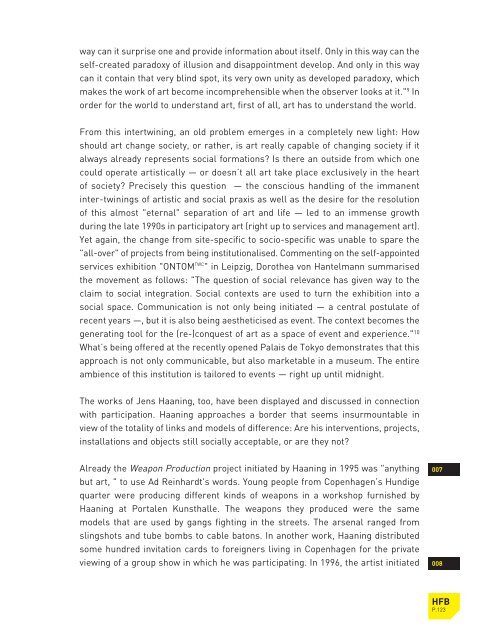download catalogue high resolution pdf (22.3 mb) - Jens Haaning
download catalogue high resolution pdf (22.3 mb) - Jens Haaning
download catalogue high resolution pdf (22.3 mb) - Jens Haaning
Create successful ePaper yourself
Turn your PDF publications into a flip-book with our unique Google optimized e-Paper software.
way can it surprise one and provide information about itself. Only in this way can the<br />
self-created paradoxy of illusion and disappointment develop. And only in this way<br />
can it contain that very blind spot, its very own unity as developed paradoxy, which<br />
makes the work of art become incomprehensible when the observer looks at it." 9 In<br />
order for the world to understand art, first of all, art has to understand the world.<br />
From this intertwining, an old problem emerges in a completely new light: How<br />
should art change society, or rather, is art really capable of changing society if it<br />
always already represents social formations? Is there an outside from which one<br />
could operate artistically — or doesn’t all art take place exclusively in the heart<br />
of society? Precisely this question — the conscious handling of the immanent<br />
inter-twinings of artistic and social praxis as well as the desire for the <strong>resolution</strong><br />
of this almost "eternal" separation of art and life — led to an immense growth<br />
during the late 1990s in participatory art (right up to services and management art).<br />
Yet again, the change from site-specific to socio-specific was unable to spare the<br />
"all-over" of projects from being institutionalised. Commenting on the self-appointed<br />
services exhibition "ONTOM TWC " in Leipzig, Dorothea von Hantelmann summarised<br />
the movement as follows: "The question of social relevance has given way to the<br />
claim to social integration. Social contexts are used to turn the exhibition into a<br />
social space. Communication is not only being initiated — a central postulate of<br />
recent years —, but it is also being aestheticised as event. The context becomes the<br />
generating tool for the (re-)conquest of art as a space of event and experience." 10<br />
What’s being offered at the recently opened Palais de Tokyo demonstrates that this<br />
approach is not only communicable, but also marketable in a museum. The entire<br />
a<strong>mb</strong>ience of this institution is tailored to events — right up until midnight.<br />
The works of <strong>Jens</strong> <strong>Haaning</strong>, too, have been displayed and discussed in connection<br />
with participation. <strong>Haaning</strong> approaches a border that seems insurmountable in<br />
view of the totality of links and models of difference: Are his interventions, projects,<br />
installations and objects still socially acceptable, or are they not?<br />
Already the Weapon Production project initiated by <strong>Haaning</strong> in 1995 was "anything<br />
but art, " to use Ad Reinhardt's words. Young people from Copenhagen’s Hundige<br />
quarter were producing different kinds of weapons in a workshop furnished by<br />
<strong>Haaning</strong> at Portalen Kunsthalle. The weapons they produced were the same<br />
models that are used by gangs fighting in the streets. The arsenal ranged from<br />
slingshots and tube bo<strong>mb</strong>s to cable batons. In another work, <strong>Haaning</strong> distributed<br />
some hundred invitation cards to foreigners living in Copenhagen for the private<br />
viewing of a group show in which he was participating. In 1996, the artist initiated<br />
007<br />
008<br />
HFB<br />
P.123


